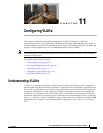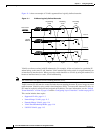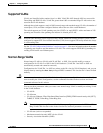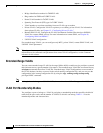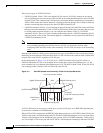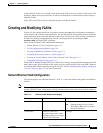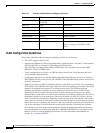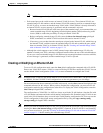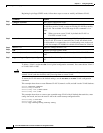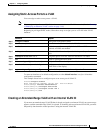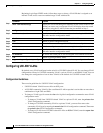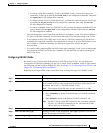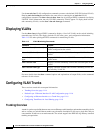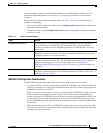
11-8
Cisco ME 3400 Ethernet Access Switch Software Configuration Guide
OL-9639-06
Chapter 11 Configuring VLANs
Creating and Modifying VLANs
VLAN Configuration Guidelines
Follow these guidelines when creating and modifying VLANs in your network:
• The switch supports 1005 VLANs.
• Normal-range Ethernet VLANs are identified with a number between 1 and 1001. VLAN numbers
1002 through 1005 are reserved for Token Ring and FDDI VLANs.
• The switch does not support Token Ring or FDDI media. The switch does not forward FDDI,
FDDI-Net, TrCRF, or TrBRF traffic.
• VLAN configurations for VLANs 1 to 1005 are always saved in the VLAN database and in the
switch running configuration file.
• Configuration options for VLAN IDs 1006 through 4094 (extended-range VLANs) are limited to
MTU, RSPAN VLAN, private VLAN, and UNI-ENI VLAN. Extended-range VLANs are not saved
in the VLAN database.
• Spanning Tree Protocol (STP) is enabled by default for only NNIs on all VLANs. You can configure
STP on ENIs. NNIs and ENIs in the same VLAN are in the same spanning-tree instance. The switch
supports 128 spanning-tree instances. If a switch has more active VLANs than supported
spanning-tree instances, spanning tree can be enabled on 128 VLANs and is disabled on the
remaining VLANs. If you have already used all available spanning-tree instances on a switch,
adding another VLAN creates a VLAN on that switch that is not running spanning tree. If you have
the default allowed list on the trunk ports of that switch (which is to allow all VLANs), the new
VLAN is carried on all trunk ports. Depending on the topology of the network, this could create a
loop in the new VLAN that would not be broken, particularly if there are several adjacent switches
that all have run out of spanning-tree instances. You can prevent this possibility by setting allowed
lists on the trunk ports of switches that have used up their allocation of spanning-tree instances.
If the number of VLANs on the switch exceeds the number of supported spanning-tree instances,
we recommend that you configure the IEEE 802.1s Multiple STP (MSTP) on your switch to map
multiple VLANs to a single spanning-tree instance. For more information about MSTP, see
Chapter 15, “Configuring MSTP.”
IEEE 802.10 SAID 100001 (100000 plus the
VLAN ID)
1 to 4294967294
MTU size 1500 1500 to 9198
Translational bridge 1 0 0 to1005
Translational bridge 2 0 0 to1005
VLAN state active active, suspend
Remote SPAN disabled enabled, disabled
Private VLANs none configured 2 to 1001, 1006 to 4094.
UNI-ENI VLAN UNI-ENI isolated VLAN 2 to 1001, 1006 to 4094.
VLAN 1 is always a UNI-ENI isolated
VLAN.
Table 11-2 Ethernet VLAN Defaults and Ranges (continued)
Parameter Default Range




